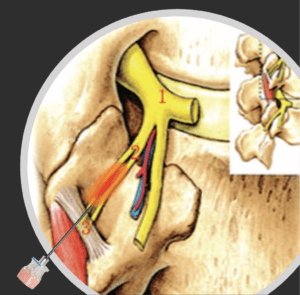What is a Medial Branch Block?
A medial branch block (MBB) is a diagnostic procedure used to determine whether your back or neck pain is coming from the facet joints in your spine. These joints are supplied by small nerves called medial branch nerves. By temporarily numbing these nerves, your healthcare provider can assess whether they are the source of your pain.
This is a diagnostic test, not a treatment. If the block reduces your pain, a longer-lasting procedure called radiofrequency ablation (RFA) may be recommended.
Before the Procedure
- No fasting or special preparation is needed — you may eat and drink normally.
- Arrange for a ride home if possible. Sedation is usually not required, but it’s safest to have someone drive you.
- Wear loose, comfortable clothing.
During the Procedure
- You will lie on a procedure table, usually on your stomach or side.
- The skin over the injection site will be cleaned in a sterile fashion.
- Using X-ray (fluoroscopy) or ultrasound guidance, a small needle will be positioned near the targeted medial branch nerves.
- A small amount of local anesthetic (numbing medication) will be injected near each nerve.
- The procedure usually takes about 15 minutes.
After the Procedure
- You may return to normal activities unless advised otherwise.
- It’s very important to track your pain for several hours after the procedure:
- Use a 0–10 pain scale to record your pain level before and after the injections.
Try to perform activities that would typically provoke your pain.
- Record how much relief you experienced and how long it lasted.
- Use a 0–10 pain scale to record your pain level before and after the injections.
Pain Relief Timeline
- If the medial branch nerves are contributing to your pain, you may notice relief starting within 15 to 30 minutes after the injection.
- Relief is typically temporary, lasting only a few hours.
- A pain reduction of 50% or more suggests you may benefit from radiofrequency ablation (RFA) for longer-term relief.
Possible Side Effects
Most people tolerate the procedure well. Side effects, if they occur, may include:
- Mild soreness or bruising at the injection site
- Temporary increase in discomfort
- Rarely, infection, allergic reaction, or nerve irritation
- If the injection was in your neck you may experience dizziness or lightheadedness
When to Seek Medical Attention
Contact your healthcare provider if you experience:
- Fever or chills
- Redness, swelling, or discharge at the injection site
- Numbness, tingling, or new weakness in your limbs
Follow-up
The physician will tell you when to make a follow-up appointment after your nerve block procedure.
Please bring your pain diary/notes to your follow-up appointment or have them with you if the follow-up is by phone. This information is critical in determining whether this diagnostic procedure was successful and what the next step should be.

